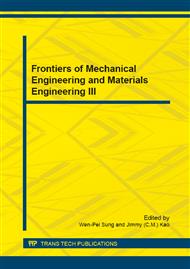[1]
T.V. Semenistaya, V.V. Petrov, P. Lu, Nanocomposite of Ag-polyacrylonitryle as a selective chlorine sensor, Advanced Materials Research. 804 (2013) 135-140.
DOI: 10.4028/www.scientific.net/amr.804.135
Google Scholar
[2]
V.V. Petrov, N.K. Plugotarenko, T.V. Semenistaya, Self-organization in the thin gas-sensitive Ag-containing polyacrylonitrile films, Chaotic Modeling and Simulation. 4 (2013) 609-614.
Google Scholar
[3]
A. N. Korolev, T. V. Semenistaya, I. S. Al-Hadrami, T. P. Loginova, M. Bruns, Nanokompozitnyie plenki medsoderzhaschego poliakrilonirila: sostav, struktura, morfologiya poverhnosti, Perspektivnyie materialyi. 5 (2010) 52-56.
Google Scholar
[4]
P. Lu, Yu.A. Gorbatenko, T.V. Semenistaya, E.V. Vorobev, A.N. Korolev, Poluchenie chuvstvitelnyih elementov sensorov gazov na osnove plenok poliakrilonitrila i serebrosoderzhaschego poliakrilonitrila i opredelenie ih harakteristik, Nano- i mikrosistemnaya tehnika. 9 (2011).
Google Scholar
[5]
L.M. Zemtsov, G.P. Karpacheva, Chemical conversion of polyacrylonitril under uncogerent IR-irradiation, High-molec. comp. 6(36) (1994) 919-924.
Google Scholar
[6]
Y. Lba, Extended ensemble Monte Carlo, Int. J. Mod. Phys. 12 (2001) 623-656.
Google Scholar
[7]
A. Mitsutake, Y. Sugita, Y. Okamoto, Generalized-ensemble algorithms for molecular simulations of biopolymers, Biopolymers. 60 (2001) 96-123.
DOI: 10.1002/1097-0282(2001)60:2<96::aid-bip1007>3.0.co;2-f
Google Scholar
[8]
J. Lee, New Monte Carlo algorithm: Entropic sampling, Phys. Rev. Lett. 71 (1993) 211-214.
DOI: 10.1103/physrevlett.71.211
Google Scholar
[9]
N. Metropolis, A.W. Rosenbluth, M.N. Rosenbluth, A.H. Teller, E. Teller, Equation of state calculations by fast computing machines, J. Chem. Phys. 21 (1953) 1087-1092.
DOI: 10.1063/1.1699114
Google Scholar
[10]
F. Wang, D.P. Landau, Efficient, multiple-range random walk algorithm to calculate the density of states, Phys. Rev. Lett. 86 (2001) 2050-(2053).
DOI: 10.1103/physrevlett.86.2050
Google Scholar


